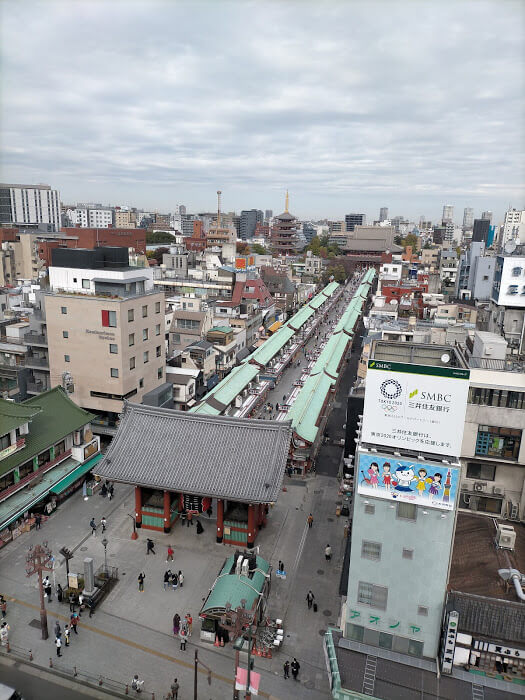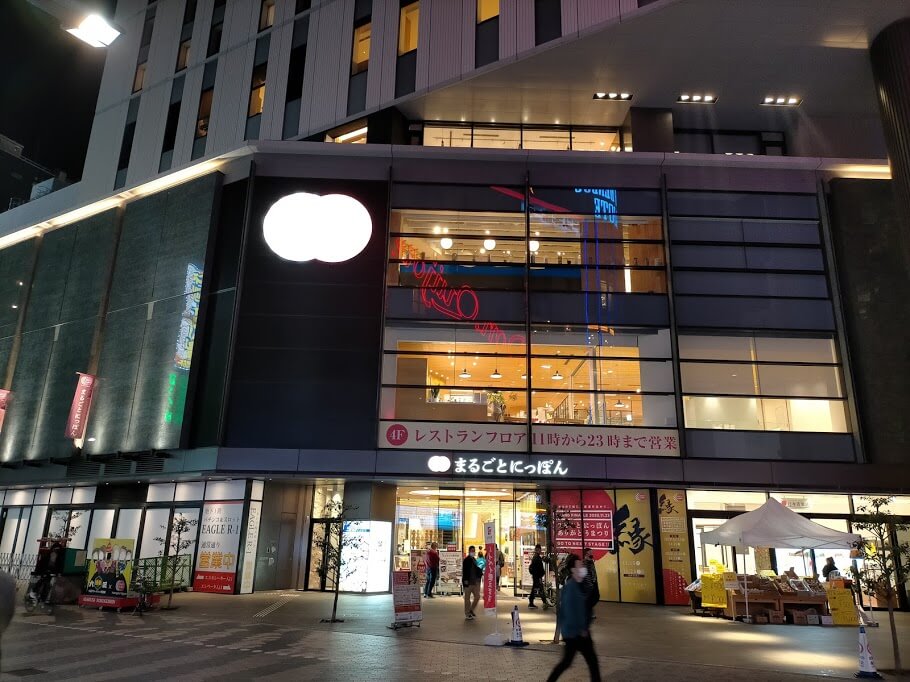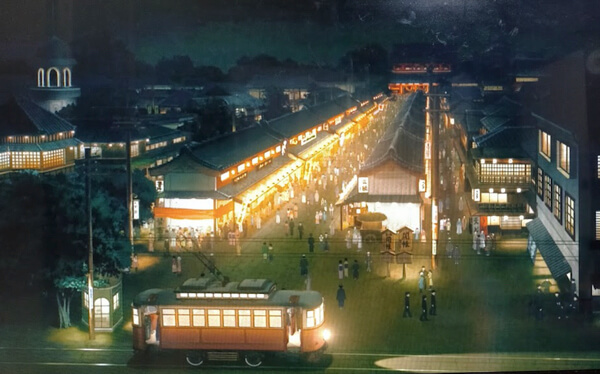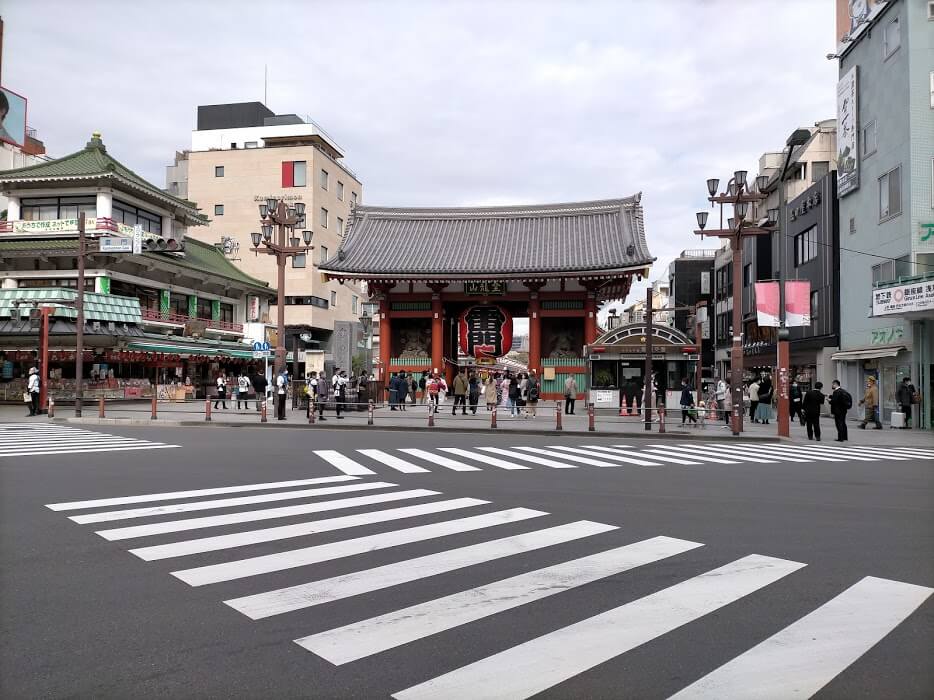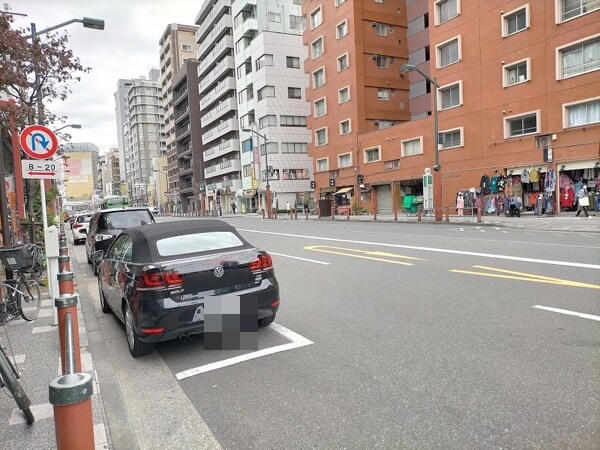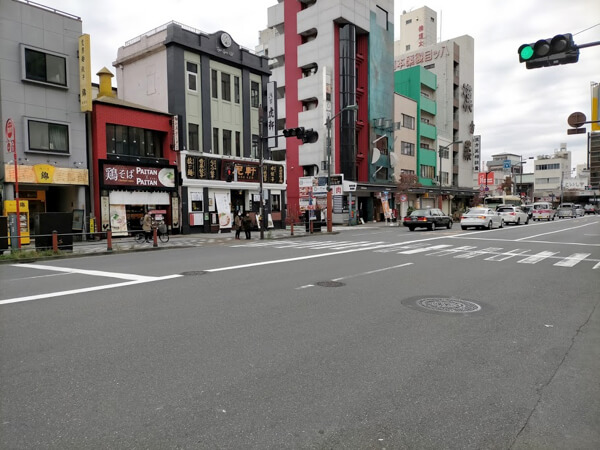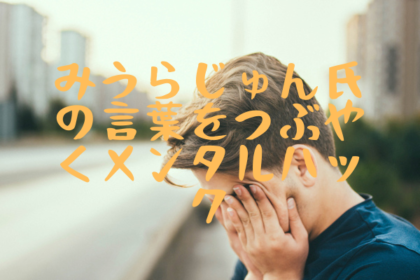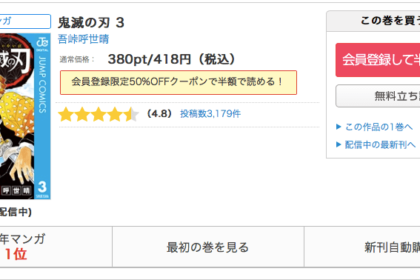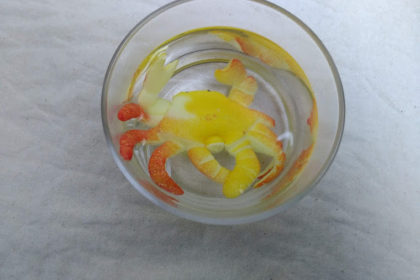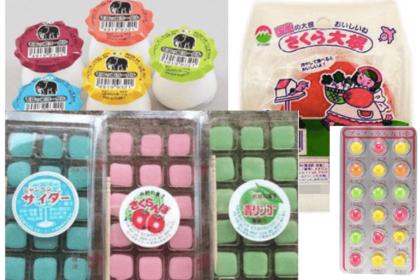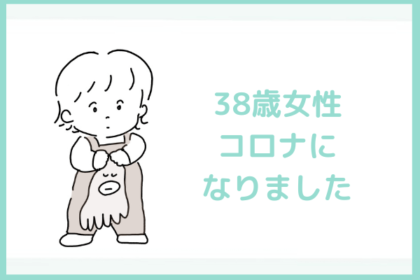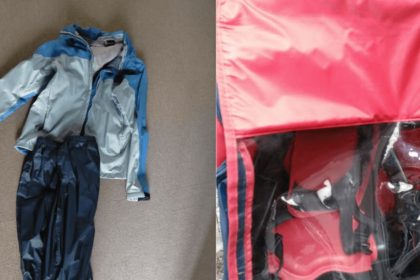Visiting the real-life locations of Demon Slayer Episodes 7- 8, Asakusa,Tokyo
The anime “Demon Slayer (Kimetsu no Yaiba)” episodes 7- 8 is set at Asakusa, one of Tokyo’s districts, in Taisho era.
*Taisho era: 1912 – 1926
In this article, I’m going to introduce the place of Asakusa that Tanjiro and Nezuko would have seen.
I was surprised that the anime version was fairly faithfully reproduced Asakusa in Taisho era, even though it was fictional.Even in a scene that only we can see for a few seconds, historical backgrounds were drawn, which made me a little move.
Now I will introduce the place drawn in the anime with the scenery of Taisho era and current scenery.
Check out Demon Slayer’s Asakusa
Taisho era is 1912 – 1926. I’ll skip the details, but Demon Slayer can be presumed to be a story among others from 1912 to September 1923.
I will show you Asakusa in this Taisho era in the following order.
1. Sensoji Temple (浅草寺)
2. Asakusa Rokku area(浅草六区)
3. The Site of Ryounkaku(凌雲閣跡地)
4. Street of Udon stall
I think it’s easy to take a walk because this route goes further and further from Asakusa station.
But at the same time, if you visit there in this order, it will become a more and more an uneventful place.So, if you would like to visit from uneventful place to a lively place,I would recommend following the reverse route.
Also, If you will actually visit there, I recommend that you don’t get your hopes up for these places.
Sensoji Temple (浅草寺)
1−1. Kaminarimon Gate(雷門)

First of all, here is the first scene of “Asakusa”.
Here is around the famous Sensoji Temple. When it comes to Asakusa, you can imagine “Kaminarimon gate” which is the entrance gate to Sensoji Temple.
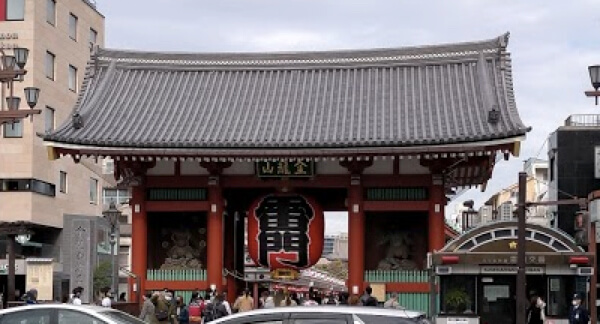
So, you may be wondering why this picture doesn’t have the gate. Did they forget to draw it?
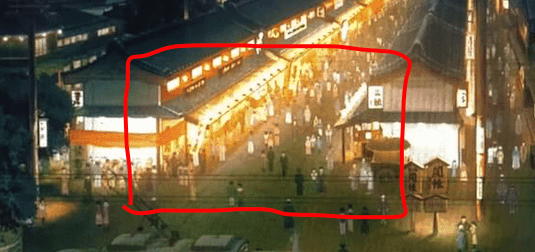
Definitely not.
Actually, Kaminarimon gate had been destroyed by fire many times.And after the destruction of Kaminarimon gate in 1865, it was not rebuilt as long as for 95 years.
In other words, Taisho era was the time when there was no Kaminarimon gate.
So the fact that Kaminarimon gate is not drawn in the anime is a result of faithful drawing in history.
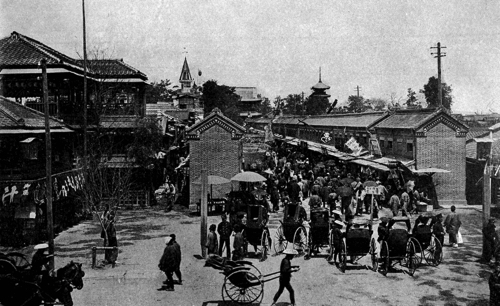
After 1865, it was properly rebuilt was in 1960, which is the current Kaminarimon Gate.
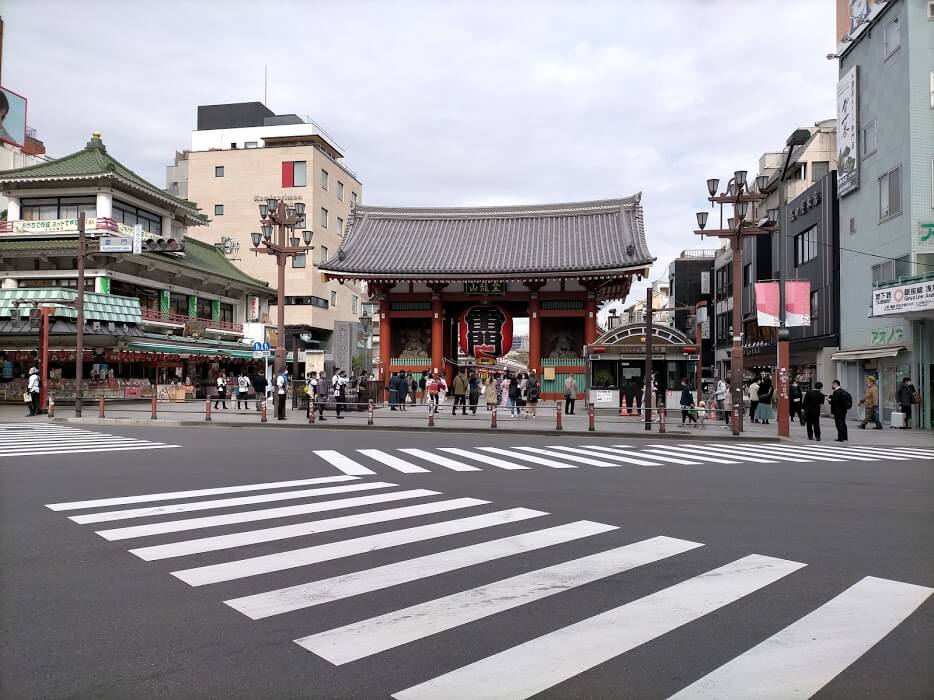
For your information, the current Kaminarimon gate is donated by the late Matsushita Konosuke, the president of Matsushita Electric Industrial Company (now known as Panasonic).
Kaminarimon Gate Location Map&Getting there
Tobu Skytree Line:7-minute walk from Asakusa Station
Tokyo Metro Ginza line:5-minute walk from Asakusa Station
Tsukuba Express:10-minute walk from Asakusa Station
Toei Subway Asakusa Line:10-minute walk from Asakusa Station
The closest and easiest to find is Exit 1 of Asakusa Station on the Ginza Line.
Tsukuba Express is a little far away, therefore I don’t recommend it.On the Toei Subway Asakusa Line, you have to go up and down a lot of stairs in the station premises (I’ve seen many people say “OMG, there’s still more stairs…” in despair), so it’s best to avoid people with wheelchairs, baby buggies, or large, heavy carry-on bags.
1-2. Nakamise(仲見世)
The next place is Nakamise. It is kind of a shopping street for temple visitors.▼
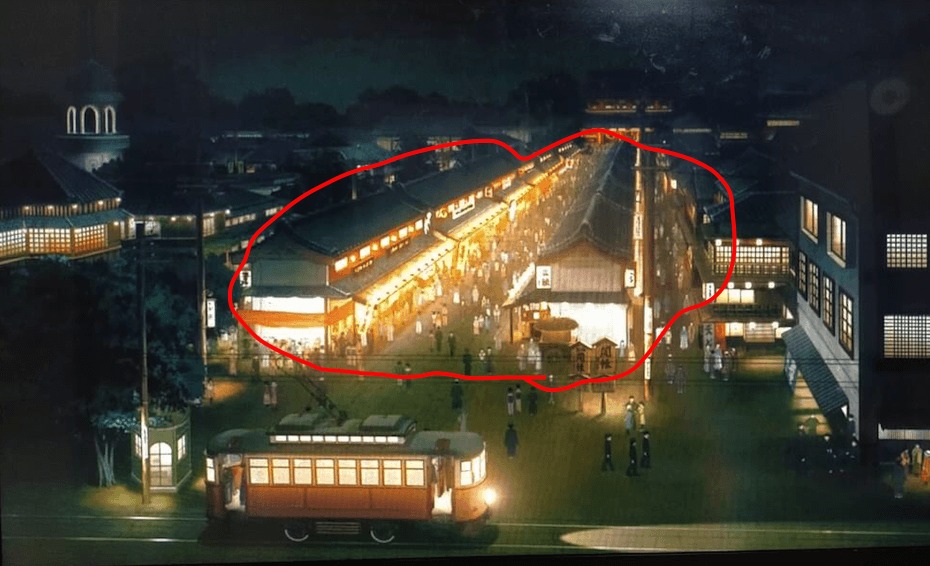
Nakamise which has a lot of shops extends 250m from Kaminarimon Gate entrance to Hozomon Gate entrance.
In Taisho era which is setting for Demon Slayer, Nakamise was a two-story Western-style building of brick construction.
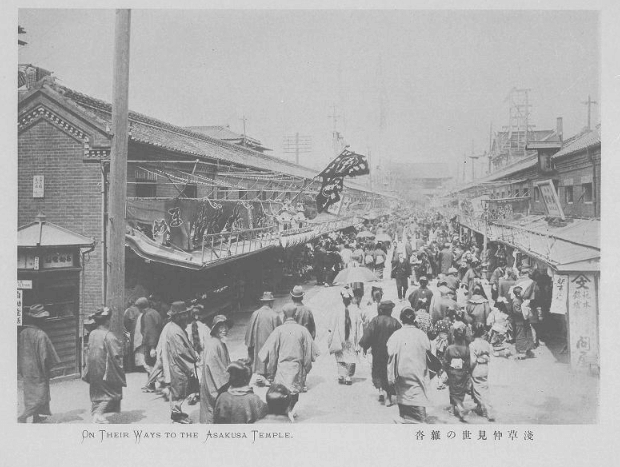
It seems that the shops provided beans, local snacks like Kaminari-Okoshi, cosmetics, dolls, Buddhist statues at that time.
Later, Nakamise made of bricks was destroyed by the Earthquake. Nakamise buildings you can see now was rebuilt with reinforced concrete.

Nakamise Location map
The local snack called “Kaminari Okoshi ” was sold even in Taisho era.And you can get it at a lot of shops on this street now.
Especially a shop, “Tokiwado Kaminari-Okoshi Main Store” on the left side of Kaminarimon, is famous as that has been over 200 years.
1−3. Hozomon Gate(宝蔵門)
Next to Nakamise is Hozomon Gate. I’m introducing it a little because you can see it in the anime.▼
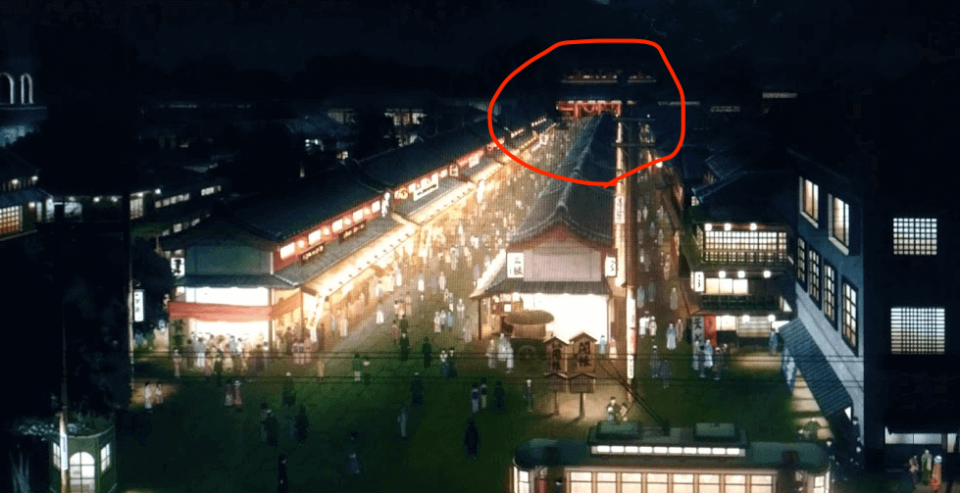
If you go through Kaminarimon Gate and walk straight through Nakamise, you will reach Hozomon Gate.
The gate at the time of Taisho era was destroyed by the bombing later.
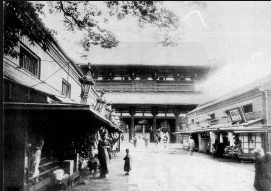
So the current gate was rebuilt by a reinforced concrete structure in 1964.

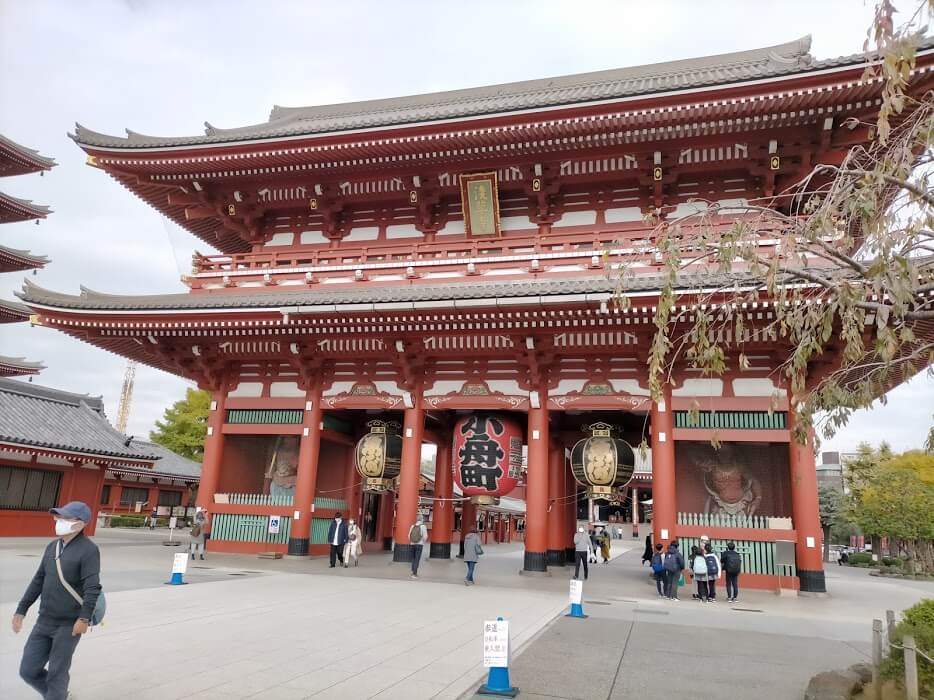
Hozomon Gate Location map
2. Asakusa Rokku area(浅草六区)

Next, Asakusa Rokku area. It takes just 10min from Sensoji temple on foot.
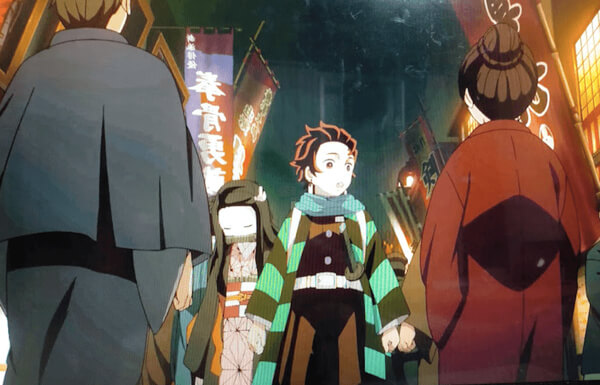
Asakusa Rokku: It is located on the west side of Sensoji.
Here used to be Tokyo’s leading entertainment district before the war. There were a lot of theaters and cinemas and so on, it filled to overflowing with people in Taisho era.
When Tanjiro arrived at Asakusa, he is astonished by the urbanity of Asakusa.
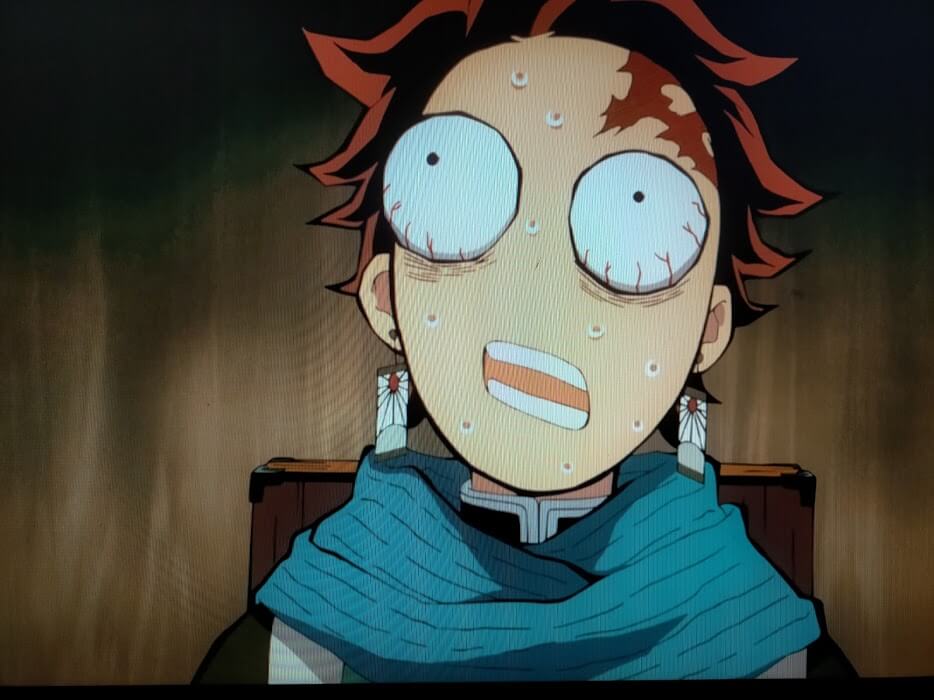
”What kind of town is this?! It’s night, but it’s bright out!! the building is so tall! what the?! the city…the city…”
The scene he sees at that time is the Asakusa Rokku.
This place drawn in the anime is…▼

I’m sure it’s exactly this place below. ▼
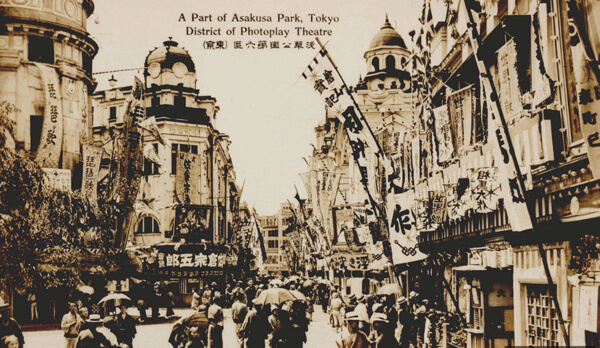
Today, the same place is like this.
If you look at Asakusa Rokku with your back to the north, you can see this scenery.▼
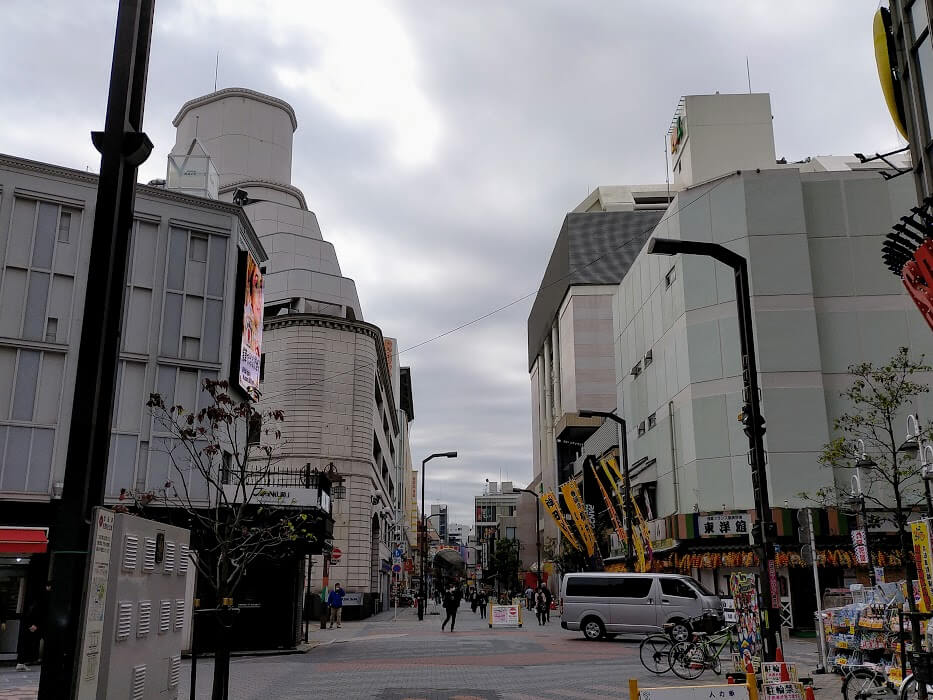
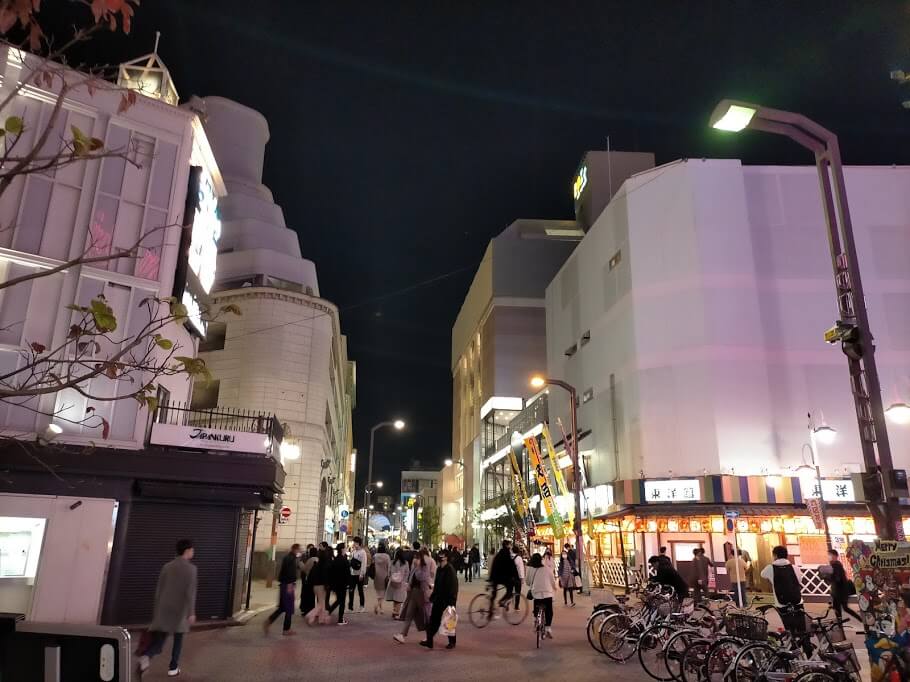
Also, Asakusa Rokku is the place where Tanjiro meets Kibutsuji Muzan for the first time.
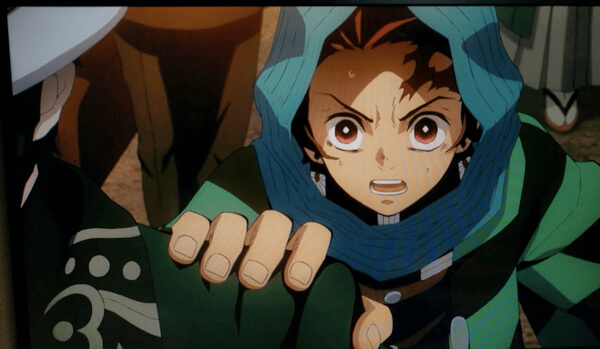
(It’s the smell that was lingering at my house! Muzan…Kibutsuji!!)
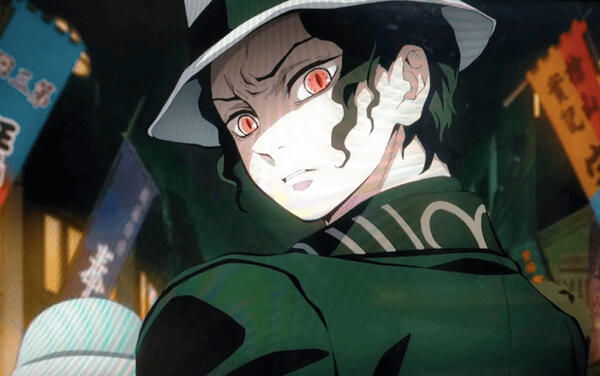
“…?”
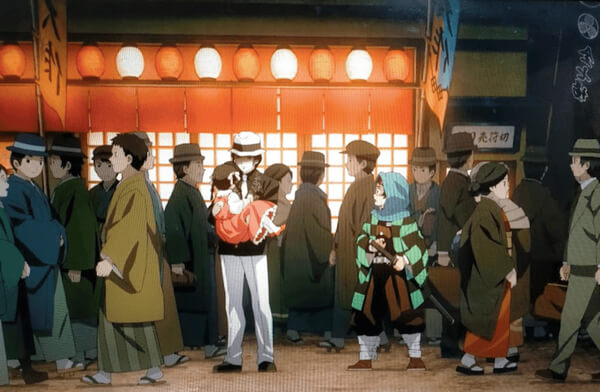
Here is also where Kibutsuji turns an innocent ordinary person who was just passing through there into a demon.
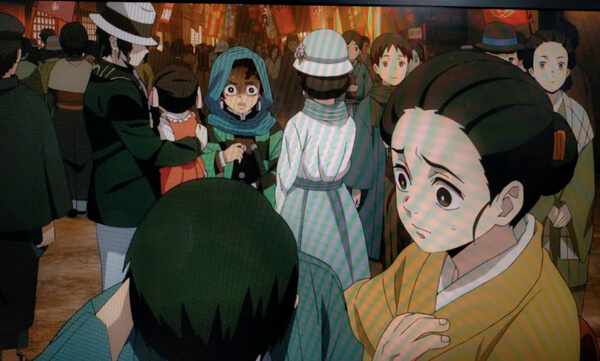
So, at the same time, it’s also the place where Tanjiro first meets Tamayo and Yushiro.
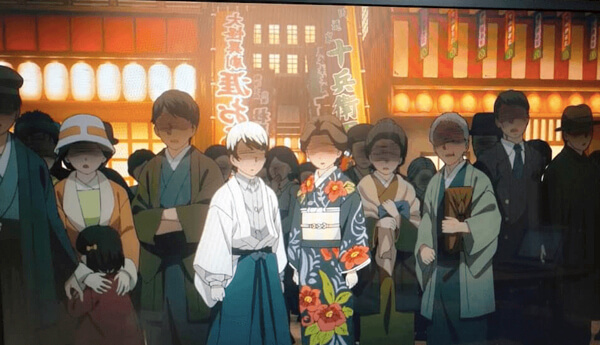
In Taisho era, Asakusa Rokku was really prosperous, just people, people, people.
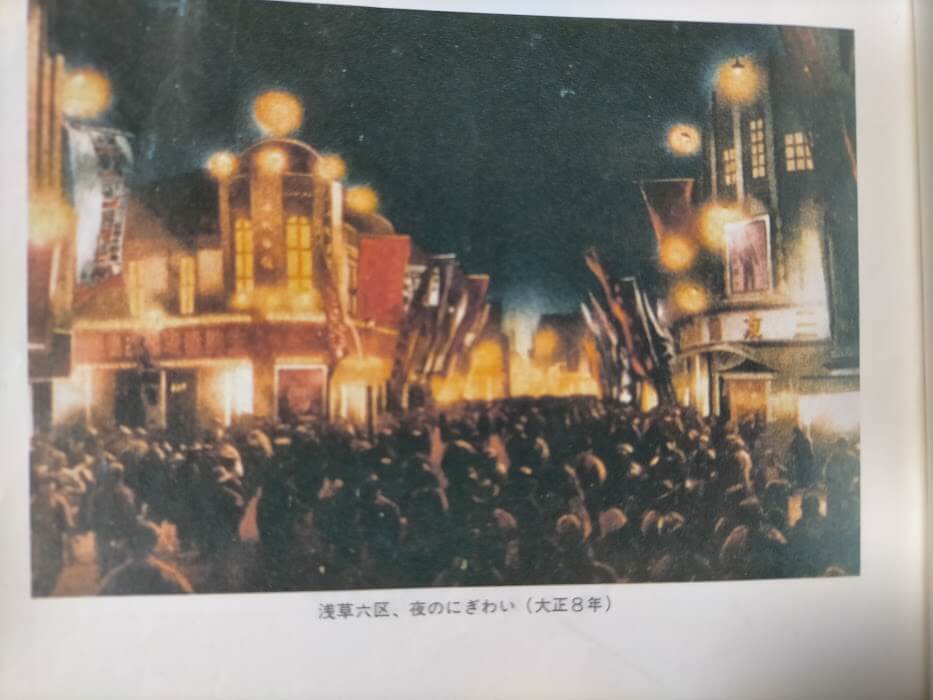
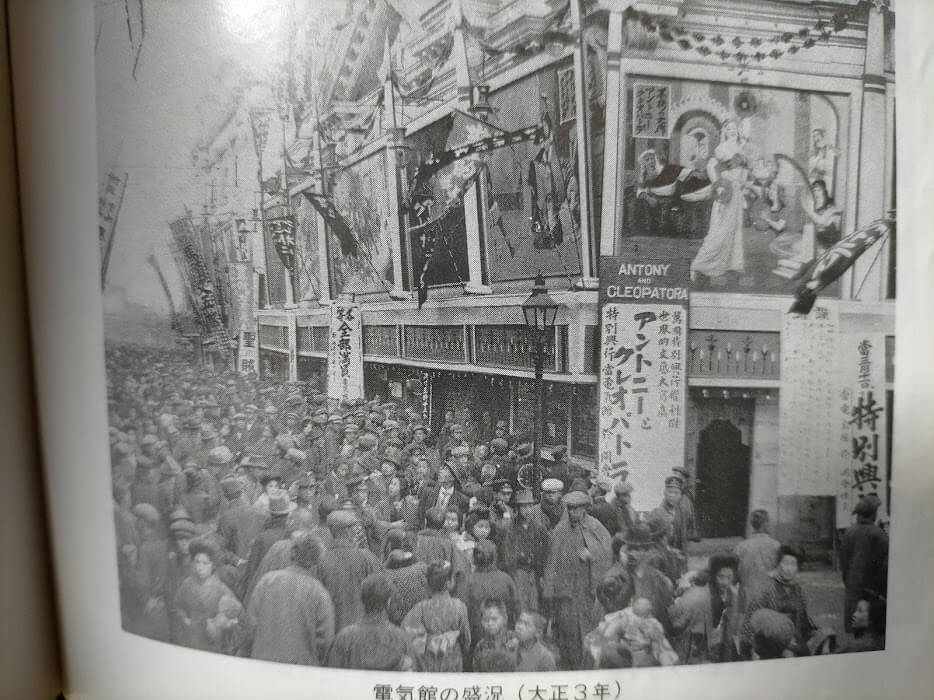
Asakusa Rokku in Taisho era flourished along with various trends such as movies, plays, opera, and so on.
However, theaters disappeared one after another after the war, the district’s popularity was declined gradually, and the last movie theater was closed in 2012. The prosperity is a shadow of former Rokku.
The only two theaters there today would be Rakugo theater called Asakusa Engei Hall and Strip Theater called Rockza.
There are not many unique buildings like those at the time, and it’s a town that isn’t special, and it’s an ordinary town where residents and tourists come and go.
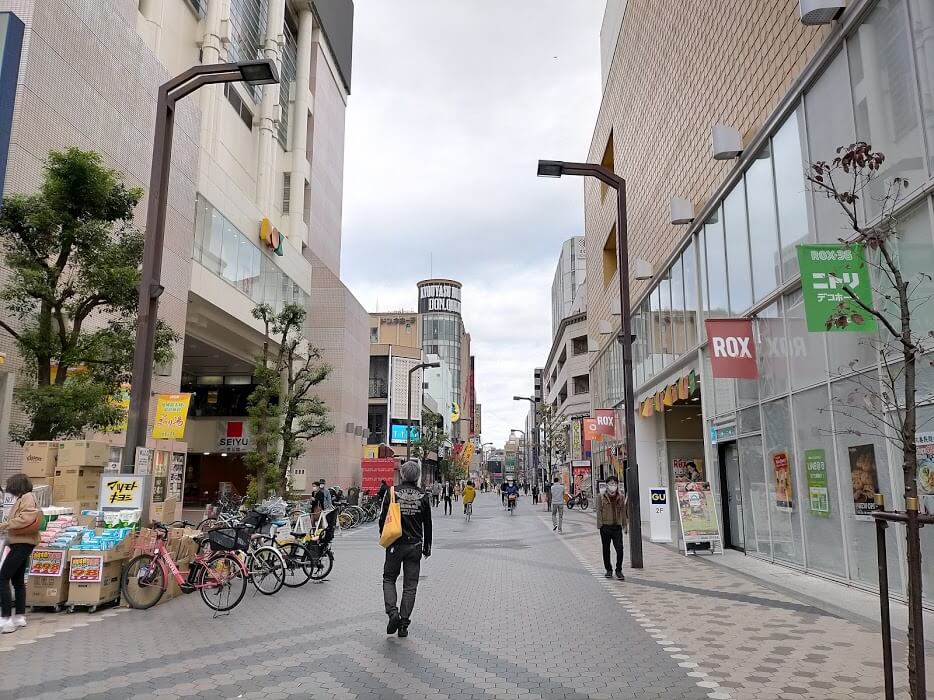
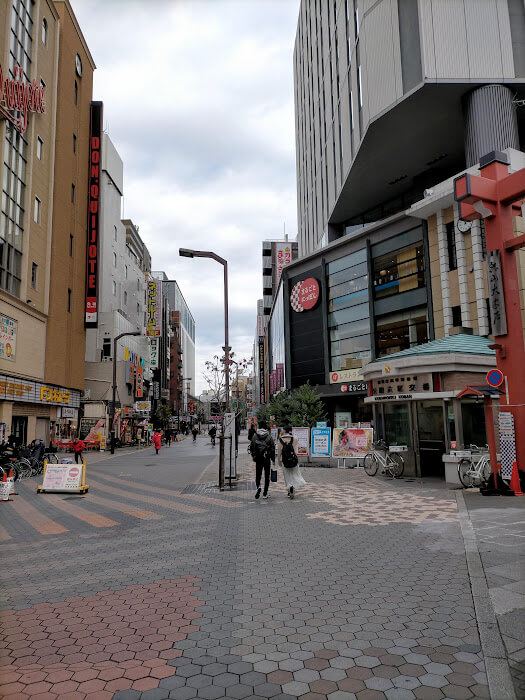
▲ Can you see the police box on the right side of the photo? Looking at the map of Taisho era, there is a police box in about the same place back then.
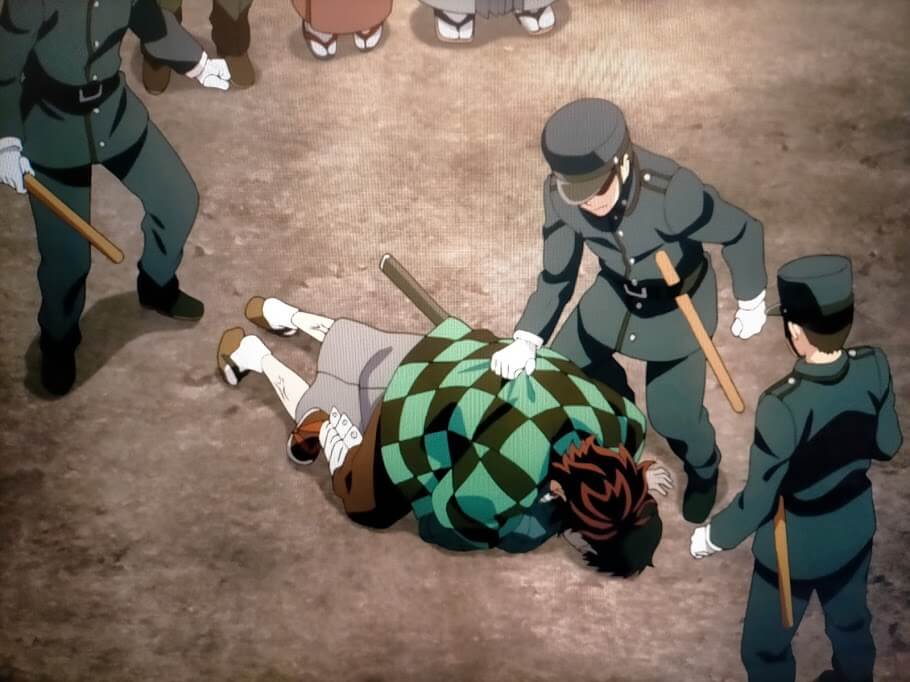
In the anime, the police came right away, right?
I was smirking at the old map, thinking that the police were probably the people from the police box here.
Asakusa Rokku Area Location Map
The area extending from north to south is a rough guide for a place called “Asakusa Rokku”.
The Site of Hyotan Pond(瓢箪池跡地)
Now, let me introduce you to this waterside.▼
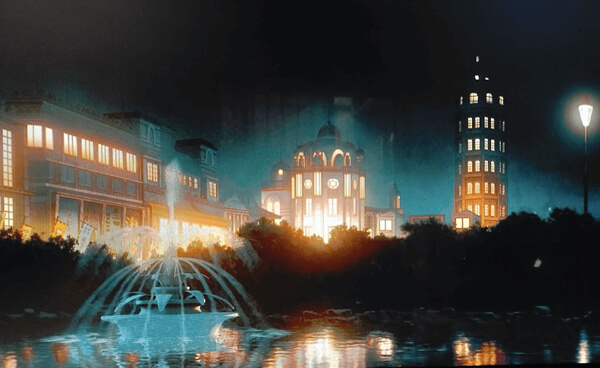
This pond, commonly known as Hyotan pond (Hyotanike), certainly existed in Taisho era.
Hyotan pond in Taisho era ▼

It was located exactly where it bordered Asakusa Rokku which I mentioned earlier.
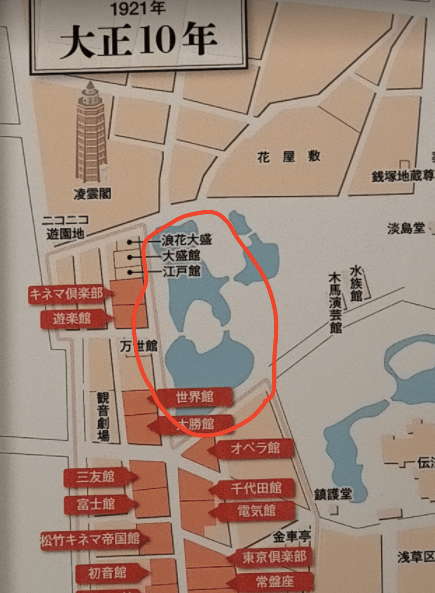
The pond was built in 1883 and reclaimed after the war, so now there are no traces of it.
From the place where I guess the pond in Taisho era was taken, hold the camera in the same way and take a picture…like this…▼
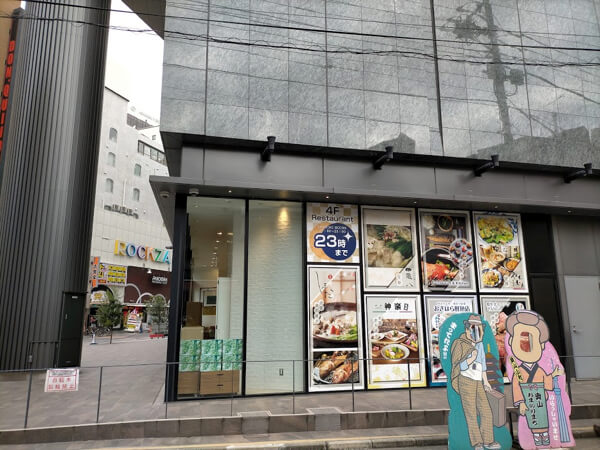
Nowadays, a facility called “Marugoto Nippon” and off-track betting facility have been built on it.
Both places use quite large land, so I feel that it was a large pond.
The Site of Hyotan Pond Location map
3. The Site of Ryounkaku(凌雲閣跡地)
Also next, there is a site of Taisho era. you can go there if you go to north from Asakusa Rokku.
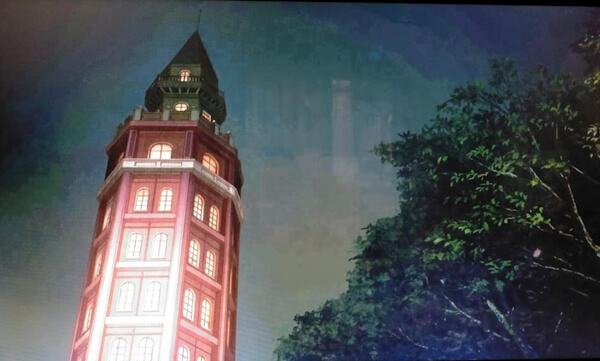
Do you remember the tower that often appears in Asakusa scene?

This is Ryouunkaku, commonly known as the “Asakusa 12-story(浅草十二階)”.
As the name implies, it was a 12-story building.
Also, do you remember the scene that Tanjiro said “The building is so tall, what the ?! ” ?
It must be the word when you see this Ryounkaku.
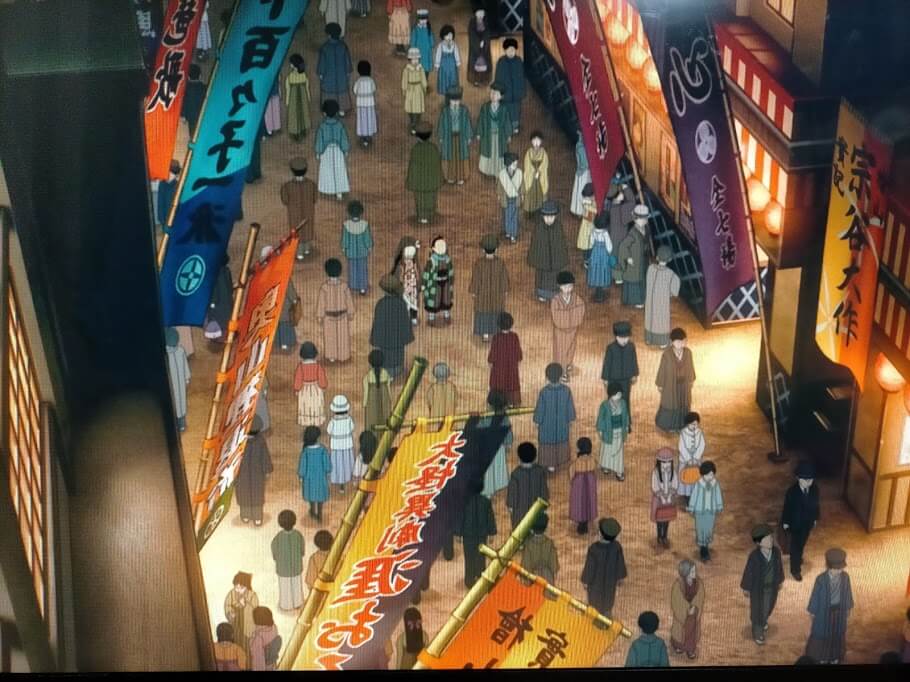
Ryounkaku was opened in 1890 and existed in Asakusa for 33 years until the Earthquake occurred in September 1923.
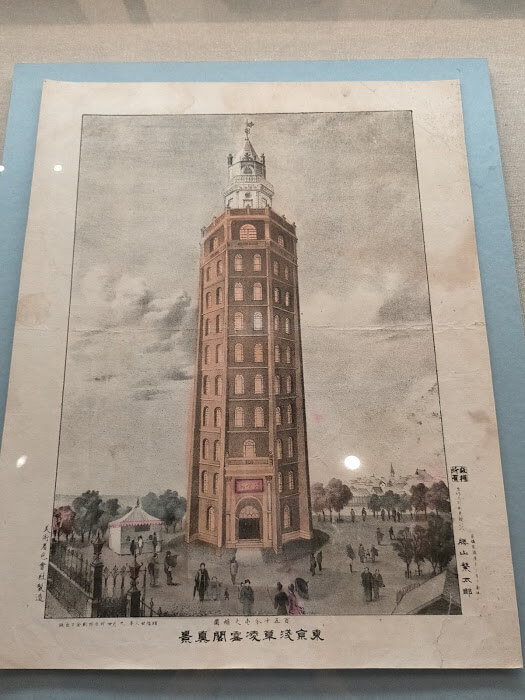
Initially, it was reported to be 67 meters high, but later measurements showed that it was about 52 meters high, including the lightning rod. I wonder what that means.

Ryounkaku was the first to operate an elevator in Japan. However, due to repeated problems, the elevator was ordered to stop operating as early as the next year after its opening.
Therefore, in order to increase the number of visitors, they started to display pictures of 100 popular geiko on the walls of the stairs on the 4th to 7th floors.
And the popularity vote started in 1891 and was well received.
The 11th and 12th floors are observatories, and if you look toward Asakusa Rokuku, you can see this kind of scenery.▼
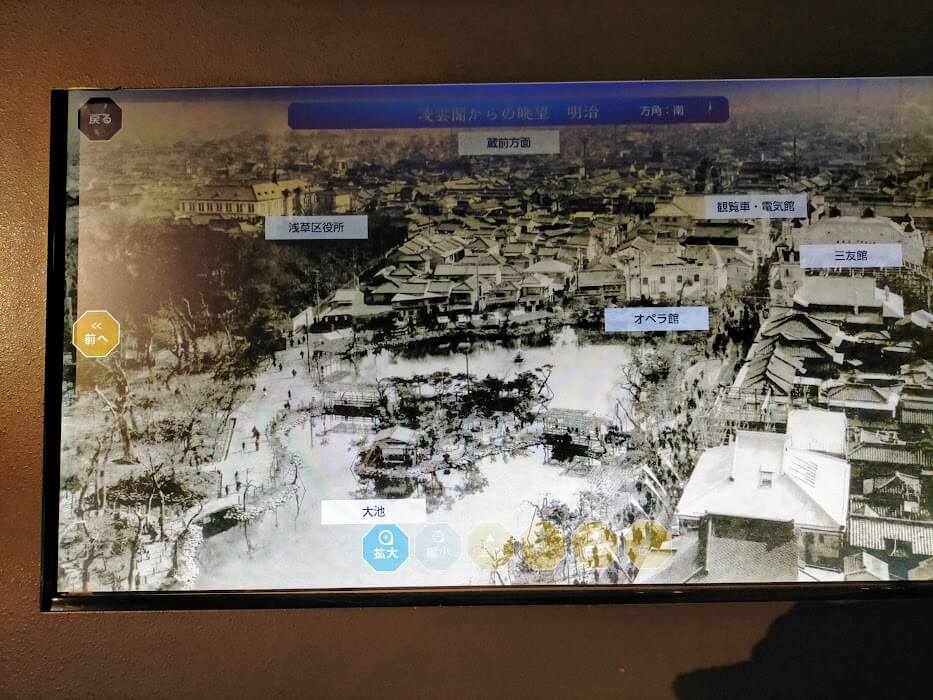
Well, Ryounkaku certainly existed in Taisho era, but…

Now the building itself is gone due to the earthquake, as mentioned earlier, so let’s look at the site.
Note that Asakusa has an information board in a place that is not the former site, of course not here.
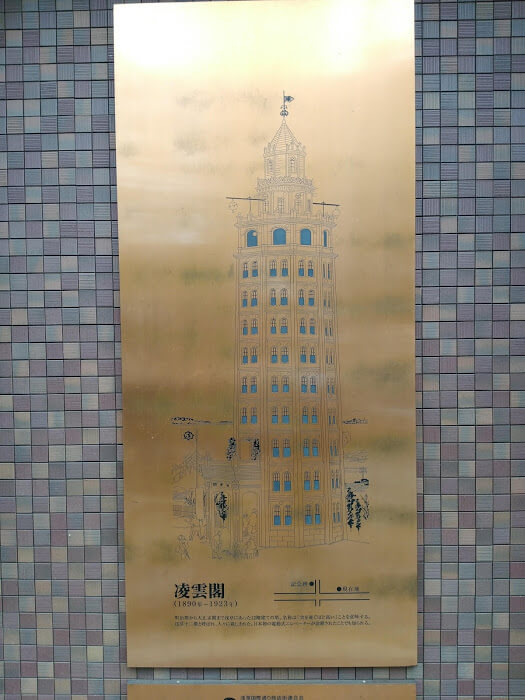
Is it because it is close to the monument?
Walking north from Asakusa Rokku, you will see a pachinko parlor.
Near the entrance, there is an inconspicuous monument, like “Ryounkaku was once around here.”
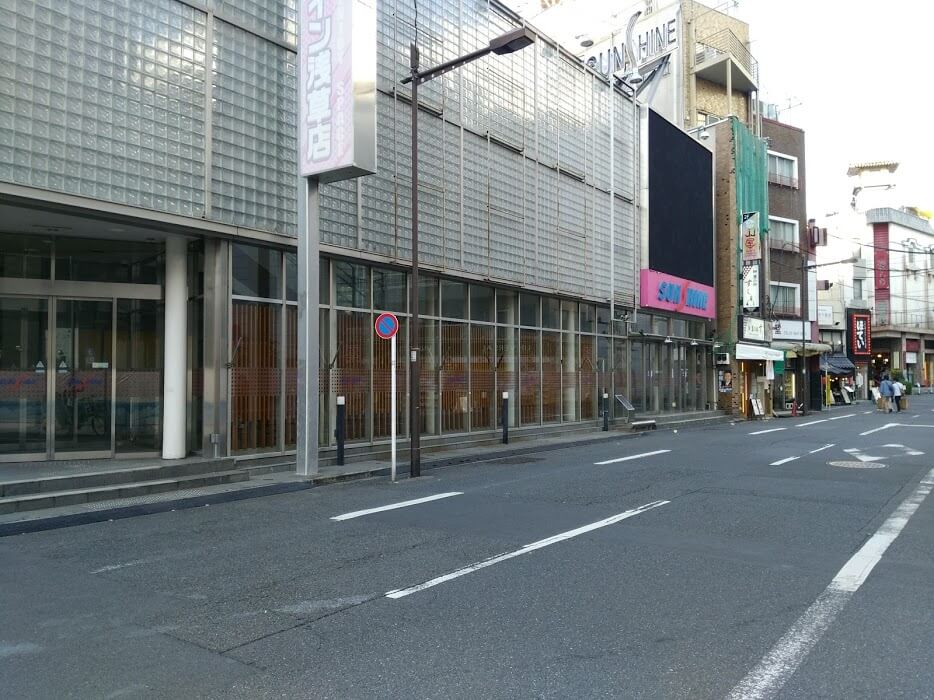
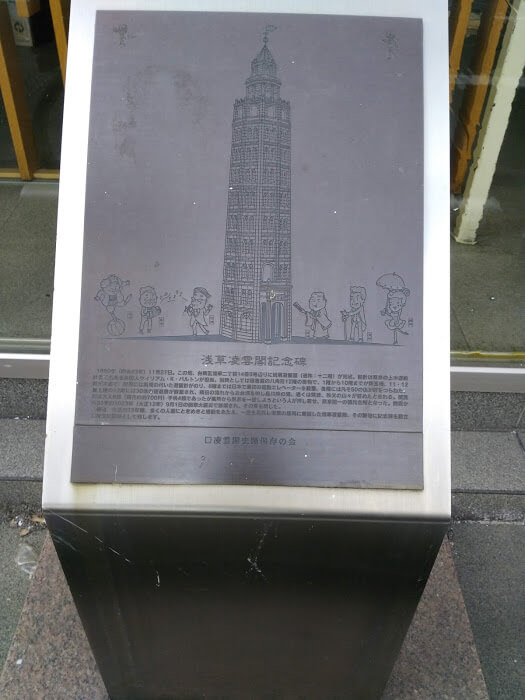
Further, enter the narrow road on the left side of the pachinko parlor…
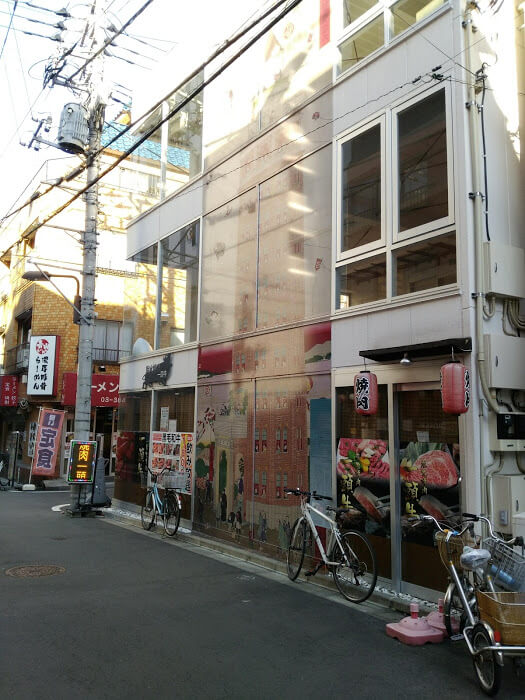
Suddenly, a picture of Ryounkaku appears in the mundane streets.
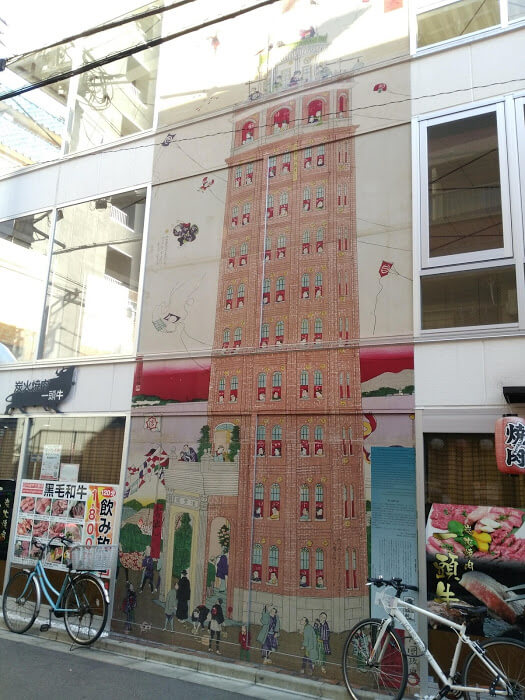
A picture of Ryounkaku seen from another angle (far right)▼
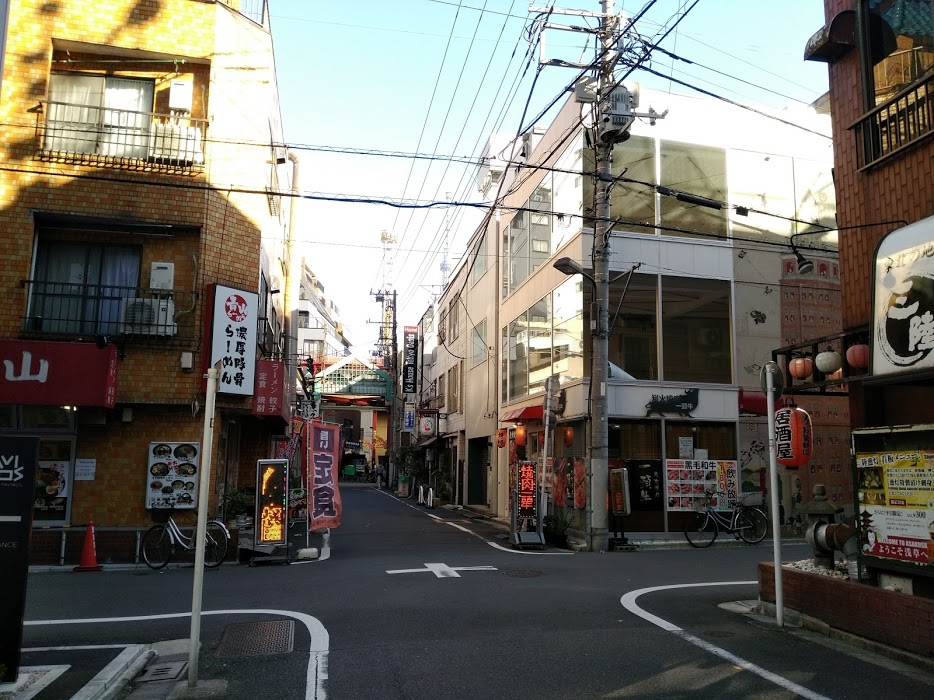
As a matter of fact, this is the place where bricks of the foundation of the Ryounkaku were found during construction in 2018.
凌雲閣基礎煉瓦
— 骨まで大洋ファンby革洋同@関根潤三さんありがとう (@FanTaiyo) February 11, 2018
ひさご通り商店街 すき焼き米久角西入る pic.twitter.com/kwte0A5MEM
Related link>Ryounkaku remains at the construction site in Asakusa, Fans gather (Jananese)
The bricks came out of the ground, but since it was suddenly excavated at the construction site, this place was not particularly preserved, and a building stand in the ordinary way now.
The site does not look like Ryounkaku at all, so please feel Ryounkaku with your mind’s eyes.
The Site of Ryounkaku Location Map
4. Street of Udon stall
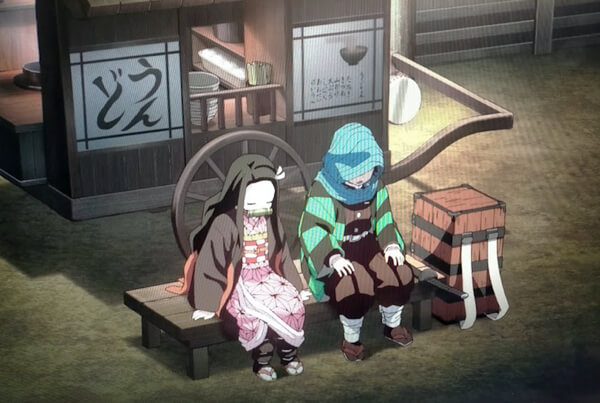
Well, Tanjiro was eating udon.
Of course, this udon stall wouldn’t have existed, and therefore this place would not have existed, and it would have been created by the Manga artist.
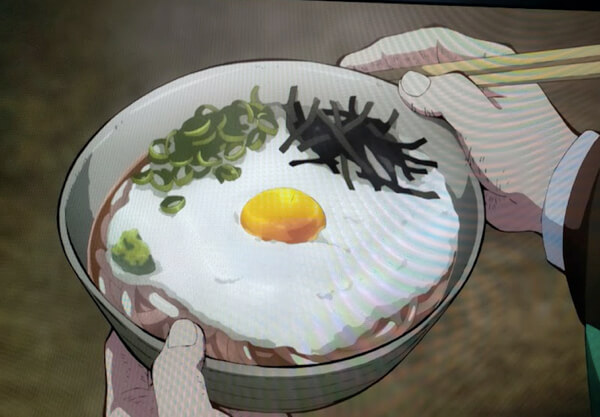
However, I dared to try to figure out the place here. I applied it to a real place even though it was a fictitious place.
When they head to the udon stall, Ryounkaku is on the left, and behind that is Asakusa Rokku.
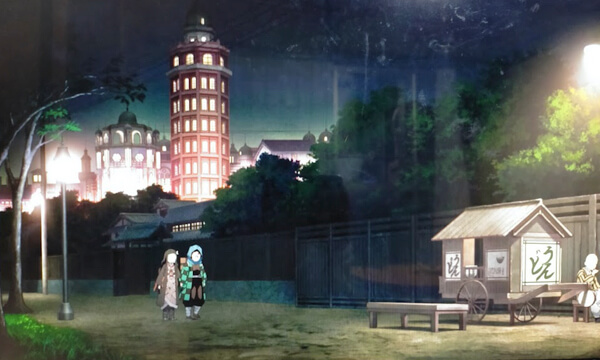
When they return from the udon shop, of course, you can see Ryounkaku on the right and the downtown area of Asakusa Rokku in the direction they are heading.
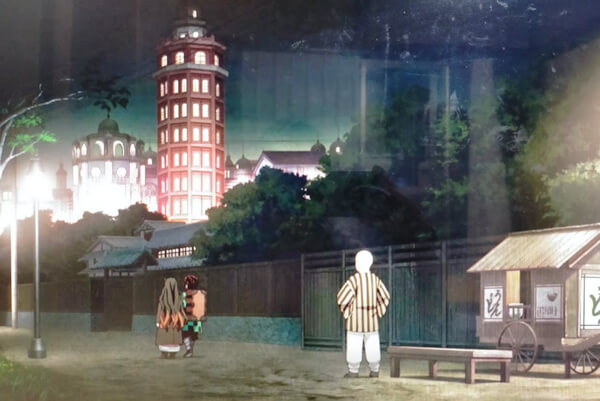
And the distance between Ryounkaku and Udon stall is close.

As above, first I checked the street where Ryounkaku can be seen up close on an old map of 1916 (red line part).▼
*1916=Taisho 5
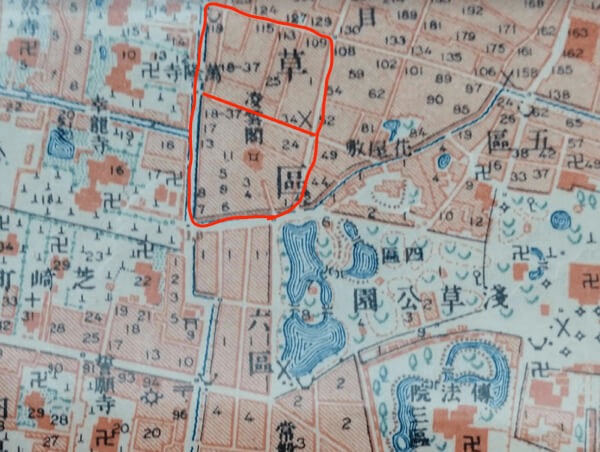
Furthermore, if I narrow down the streets that meet the conditions mentioned earlier, the streets surrounded by yellow below will be applicable. ▼
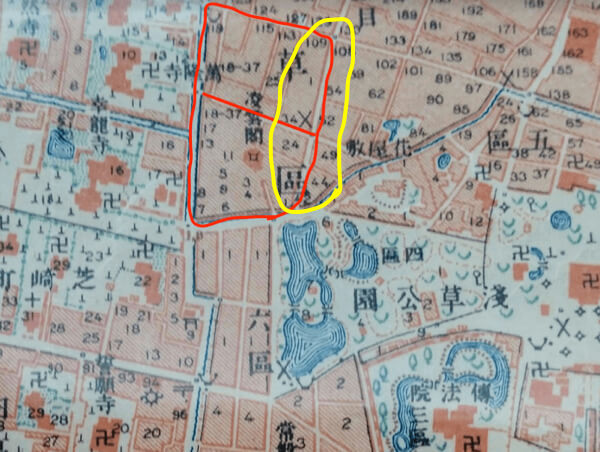
Also, I checked the street on a map of 1921(Taisho 10) and I became more confident. ▼
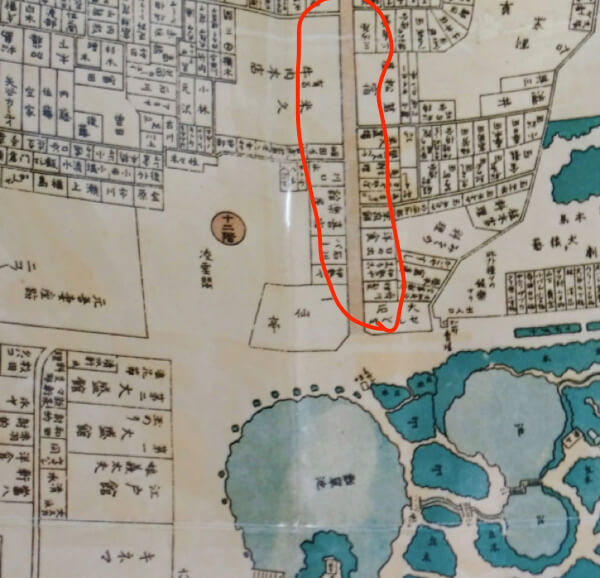
However, even if I am more convinced, the street does not seem to match up when compared to the anime. Because there are no shops nearby and trees opposite the udon stall in anime.
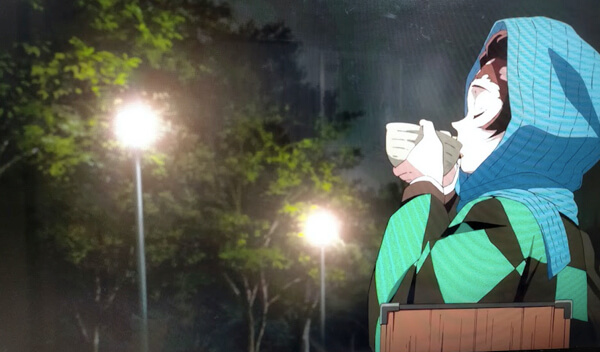
But it is natural that this does not match up because it was fiction from the beginning.
Considering from the viewpoint of wide streets, trees on the side, etc., other streets are also candidates, but here I will prioritize the positional relationship with the entertainment district and Ryounkaku over the surrounding landscape.
Therefore, I personally decided that this street is a street of udon stall in Demon Slayer.
This street is now a shopping street called “Hisagodori Shotengai”.
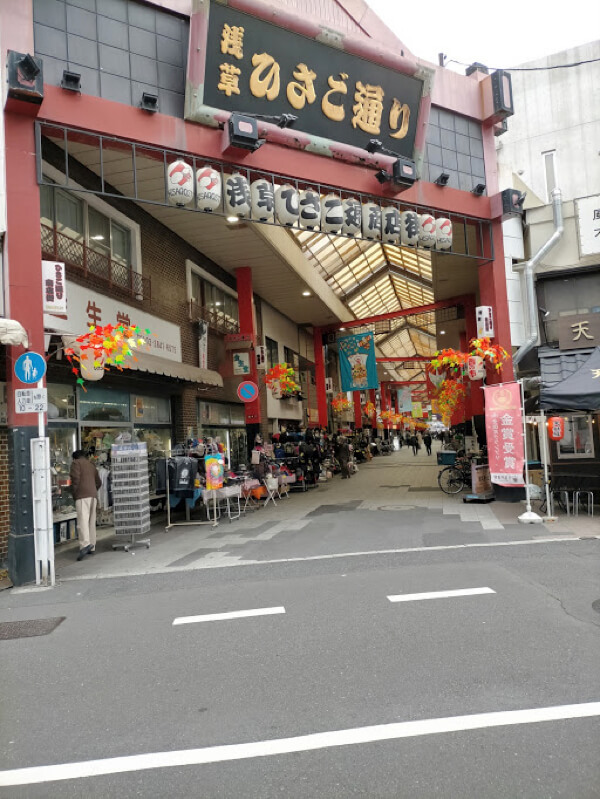
The shopping street here is mostly used by residents and is not glamorous.
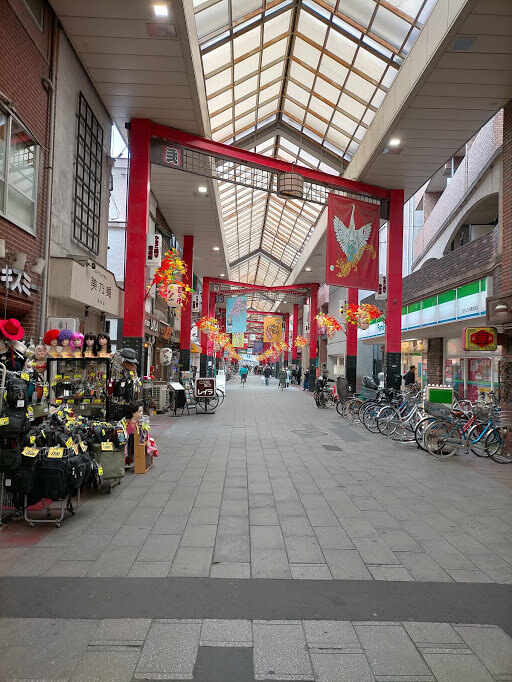
The Location Map I personally decided it’s a street of udon stall
Incidentally, there is not an udon restaurant, but a stand-up eating soba shop, in a place where “if it existed, it would be located around here”.

It is small shop called “Honjin Soba”.
An Extra: The road on which the streetcar was running
Now finally, Let’s talk about where the train was running.
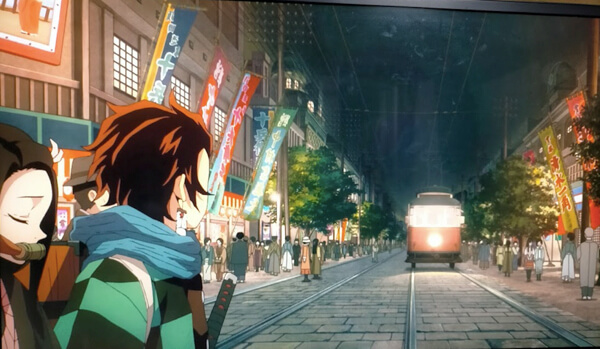
There are many trains in Asakusa today, but there are no streetcars.
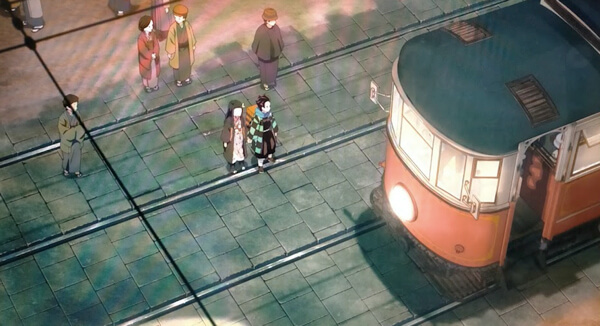
However, Asakusa has a history that began with the horse-drawn streetcars in the Meiji era (1868-1912), which were later replaced by streetcars.

Looking at a map of 1916(Taisho 5), you can see that there are indeed streetcars running through Asakusa. ▼

▲The places shown in the anime are the areas circled in yellow.
The right one is in front of Kaminarimon Gate.▼
The road straight down from Kaminarimon Gate to the south also make you feel a trace of the streetcar’s days.
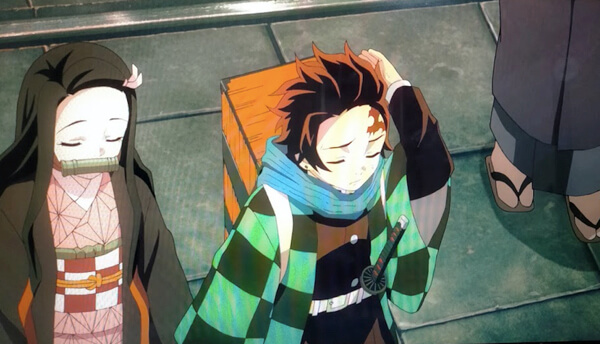
If I guess where Tanjiro and Nezuko would have seen the streetcar, it seems the place that they went south in Asakusa Rokku (old map, yellow circle on the left).

These place where the streetcar was running is today’s wide road called “Kaminarimon-dori”, which can be seen immediately while looking at Kaminarimon Gate or going south in Asakusa Rokku.
It’s an ordinary road, so it might not be interesting to visit, but you might want to check it out while you’re looking somewhere else.
It has a slightly different flavor when you think of the streetcars that used to run in the past.
The Location Map of The road on which the streetcar was running
Well, This article’s been longer than I expected, but thank you for reading this far.
Asakusa is still an interesting town, but if you’ve seen Demon Slayer, it’s even more fun.Take a lot of walks in Asakusa while thinking about Demon Slayer and Taisho era.

